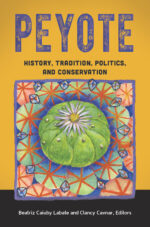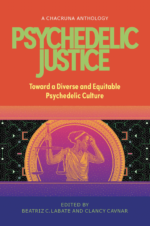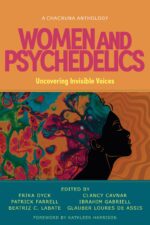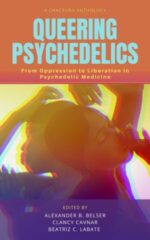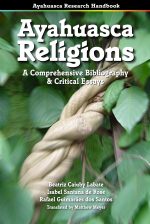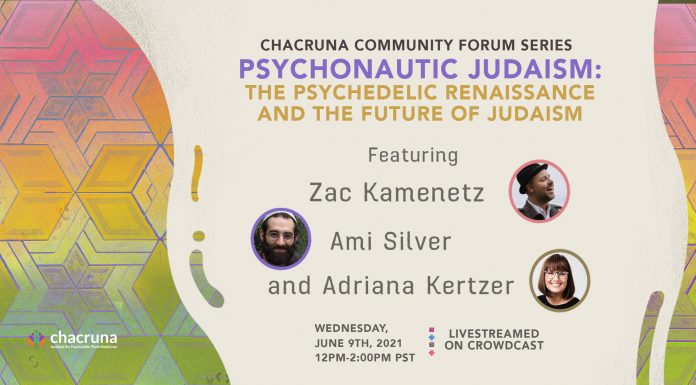- After 2024, the Scenario for Psychedelic Therapies Can Only Improve - January 16, 2025
- Symposium in Brazil Debates Psychedelics at a Political Crossroads - December 13, 2024
- Conference in Rio Defends Psychedelics in Public Health - December 11, 2024
Part 1 – Inhaling jurema’s DMT is like going to the cinema
It is 7:25 am at the Onofre Lopes University Hospital (HUOL) at the Federal University of Rio Grande do Norte (UFRN). Fernanda Palhano-Fontes, Marcelo Falchi, Sophie Laborde, Nicole Galvão-Coelho, Isabel Wießner, and Aline Assunção are already at the room in downtown Natal, capital city of the Rio Grande do Norte state in Northeast Brazil.
The room at the HUOL was carefully decorated to provide comfort to the study volunteers who would be taking DMT (N,N-dimethyltryptamine). The armchair reserved for the guinea pig is reclining and comfortable. The electroencephalography (EEG) device, Volcano vaporizer, headphones, nursing equipment are all ready.
They explain to the journalist what would take place, recalling previous agreements made in the screening sessions with Falchi, and preparation, with Laborde. They could, for example, touch his arm or hold his hand, if necessary.
The duration and sequence of the experiment are then described: several blood and saliva collections, two doses of DMT, one EEG before and one after each peak in the psychedelic experience, completion of questionnaires and scales, and two rapid integration sessions with the psychologist.
The small orchestra performs under the baton of physicist Dráulio Barros de Araújo, a neuroscientist at the Instituto do Cérebro (ICe) (Institute of the Brain) at UFRN. He enters the room, checks that everything is in order, and gives the green light to start the session.
It is the fourth rehearsal in the pilot phase of a clinical trial to investigate the antidepressant effect of inhaled DMT or DMT injected into the muscle. The experiment would begin in earnest the following month, June, with the first healthy volunteers without depression but with previous experience in the use of psychedelics.
According to the World Health Organization (WHO), almost 300 million people—5% of the world’s adult population—live with depression. Considering that a third of depressed people find no relief from available antidepressants, treatment alternatives to reduce so much suffering are greatly lacking.
This new study builds on the ICe research that resulted in the 2018 publication of the first controlled study in the world with a psychedelic substance to treat depression, together with a control group of patients who took a placebo. On that occasion, ayahuasca was used. This religious sacrament, researched mainly at the UFRN and the University of São Paulo (USP) in Ribeirão Preto, helped establish Brazil in third place among countries in terms of articles with the greatest impact on the renaissance of psychedelic science, starting in 2000.
After this pioneering study, Araújo spent two years at the University of California at Santa Barbara. He returned with the project to test the potential of DMT, the psychoactive compound in ayahuasca that is credited with the antidepressant effect, but in a different experiment.

He was convinced of the need to shorten the psychedelic session for therapeutic purposes. The “force” of the ceremonial tea, as adherents of religions such as Santo Daime, Barquinha, and the União do Vegetal (UDV) say, can last three to four hours.
Such a long trip would be difficult to fit into the clinical context, as it would require a trained therapists to be present at all times. This would make the procedure more expensive, if approved, and restrict the number of patients that could be treated.
Other psychedelics being researched for use in psychiatric disorders have similar difficulties. The use of MDMA (methylenedioxymethamphetamine), often referred to as “ecstasy” or “molly,” for post-traumatic stress, for example—the therapy closest to being regulated in the US—can last six hours.
This is about the same length as a session with psilocybin, the so-called “magic” mushrooms,” also used in clinical trials against depression. LSD is less studied today, not only because of the stigma acquired in the War on Drugs since the 1970s, but also because the trip can exceed eight hours.
Ayahuasca, if it were for medical use, would present an additional problem: It varies a lot from place to place, and is prepared by boiling two plants, the leaves of the chacruna (Psychotria viridis) and the mariri or jagube vine (Banisteriopsis caapi). The variation in the respective quantities and in the duration of cooking makes its standardization and dosage control difficult, if not impossible; hence the preference of some research groups, such as Araújo’s, to use pure DMT. In the case of UFRN, the compound has been extracted from the jurema-preta (black jurema) tree (Mimosa tenuiflora), which is widely found in the dry Caatinga Region of Northeastern Brazil.
This plant has become the main ingredient of what became known as “juremahuasca,” a combination of tea made from the bark of its root with Syrian rue (Peganum harmala), a plant originally from dry areas around the Mediterranean. This ayahuasca analogue is widely used by urban neoshamans in Brazil and Europe. In the Netherlands, for example, juremahuasca was investigated in a study by the University of Maastricht for its antidepressant effect. Published in January 2022, in the journal Psychopharmacology, the article found that the benefit had lasted for up to a year for 12 of 17 participants in neoshamanic ceremonies seeking help for moderate to severe depression.
When inhaled, dimethyltryptamine has a short acute effect, lasting 10 to 15 minutes. Absorbed into the blood stream by the lungs, it quickly reaches the brain, bypassing the digestive system, where DMT is made inactive by enzymes (in ayahuasca, the vine provides inhibitors of these enzymes, while in the case of jurema, they come from other plants, such as Syrian rue). In crystal form and mixed with herbs for combustion, pipe-smoked DMT is known in non-academic circles as changa. Another route of administration about to be investigated at UFRN is intramuscular injection, which has an effect lasting for less than an hour.
The UK-based company Biomind, directed by Uruguayan businessman Alejandro Antalich, has signed an agreement with the UFRN to promote clinical testing, DMT extraction, synthesis research, and animal testing. The partnership guaranteed overhead transfers to the university and the institute as a whole, in addition to funds for Araújo’s laboratory.
Antalich, director of ICC Labs, the first company to produce marijuana for a national government—that of Uruguay—was responsible for selling ICC Labs to the Canadian company, Aurora Cannabis. After the deal, he has fought to apply his business and regulatory experience with controlled substances to the embryonic psychedelic industry. It took three months of searching for a scientist for the task; then, he saw a presentation by Araújo. For 50 year-old Antalich, the previous work on ayahuasca and depression presented there made the UFRN neuroscientist a very suitable partner for Biomind.
In Projeto Dunas, as the research was called (besides, informally, “DMT from A to Z”), the agreement with Biomind allowed the formation of a team of 20 people, including psychiatrists, psychologists, chemists, nurses, animal experimenters, and physiologists. The laboratory was set up with the funds obtained to process jurema-preta, as well as paying for the rooms in which the human experiments are taking place.
Following the group of healthy volunteers, it will be the turn of patients with treatment resistant depression to inhale DMT; now, with the drug formulation provided by Biomind. In the next phase, the sequence will be repeated with the injection of the same substance produced according to strict parameters for clinical use.
With no further mishaps, such as the Covid pandemic that delayed the start of the study, the plan is for it to be completed by the end of 2023.
Following the group of healthy volunteers, it will be the turn of patients with treatment resistant depression to inhale DMT; now, with the drug formulation provided by Biomind. In the next phase, the sequence will be repeated with the injection of the same substance produced according to strict parameters for clinical use.
Putting on the white EEG cap with 32 electrodes takes a while. Medium-sized, it doesn’t fit very well on a large head and puts pressure on the ears. The solution of Wießner, Palhano-Fontes, and Falchi was to leave them inside; but then, an electrode on the right side is a little farther away from the skull and does not emit a signal. A little more gel, and the difficulty was solved.
Accessing the vein in the right arm also takes work; not immediately, only after the second dose. Assunção, the nurse, is unable to collect blood at 5 and 10 minutes; that is, 2 out of 11 collections fail. She attributes the difficulty to clots that form in the very thin silicone catheter inserted into the blood vessel. Once or twice the blood leaks out, and she wipes the arm with alcohol. None of this bothers the volunteer, and the information seems to reassure her, given the tension with tight collection schedule and the risk of blood hemolysis (when red blood cells rupture under pressure and impair centrifugation to separate them from the serum for analysis).
Falchi shows the metal mesh with 30 mg of DMT that goes in the vaporizer. After training using the balloon three times, without the substance, it’s time for the real inhalation.
It is not easy to empty the two-liter reservoir, as DMT irritates the airways. Repeated swallowing reflexes make it possible to hold one’s breath for 10 seconds, after emptying the rustling plastic that the psychiatrist crumples up to help with drainage. With the gas trapped in the lungs, they recline the beige armchair for the reporter’s takeoff.
The visual effect was similar to that of smoking changa on the beach of Algodões in the State of Bahia in March, during the Equinox neoshamanic festival. Cold arms, and the impression was that everything was fleeing, fainting seeming imminent, with enormous lightness, like floating in space.
The departure is dizzying, and everything is immediately colored. It is very difficult to retain and describe the images. They seem two-dimensional, as if projected on the screen of closed eyelids, somewhat fractal, but not geometric or kaleidoscopic.
They are more organic fractals, with curved boundaries between colors, not straight lines or angles. Shapes that are repeated with the predominance of yellow, brown, orange, and red, with little blue, green, and purple. Beautiful, but less ebullient than the changa images, similar to arabesques in an Istanbul mosque. Even with the altered perception of time, it is clear that the visual phase of the trip lasts only a few minutes. Someone touches the reporter’s arm to let him know that they were going to record the EEG and ask him to alternate eyes open with eyes closed.
The first recorded part, five minutes with headphones, in which the music of Raphael Egel, Wießner’s husband is playing, is peaceful, as is the opening-and-closing succession of eyelids. Everything seems amusing, full of moments of a pleasant mood. Lots of smiles and pleasure. A joyful experience with those researchers, although not exactly in connection with them, as everything is more internal.
Another five minutes with eyes closed, now without music, and it is difficult not to fall asleep. Fleeting images of an unknown boy emerge, as when someone is slipping into sleep. After that first dose, there is a surprise when the Falchi, the doctor, says that 40 minutes have passed. He asks if he could move on to integration and psychometric scales. It all sounded amusing, but reasoning was impaired. There was some difficulty in understanding and marking the vertical lines with a red pen on the intensity and quality (pleasant/unpleasant) evaluation scales of the experience.
Even with the altered perception of time, it is clear that the visual phase of the trip lasts only a few minutes. Someone touches the reporter’s arm to let him know that they were going to record the EEG and ask him to alternate eyes open with eyes closed.
Sophie Laborde, 25 years-old, is in charge of carrying out conversations evaluating the experience that psychologists like her and psychiatrists like Falchi call “integration.” She is nearly 40 years younger than the journalist. Despite the age difference, the conversation about the volunteer’s intimate feelings flows without barriers.
With a graduate degree in psychology from UFRN, she is one of the few people from the humanities in the group of natural scientists at Araújo’s laboratory in the ICe. The clinical trial will be the subject of her master’s thesis. Her interest in psychoactive substances arose from her contact with ayahuasca at a difficult time in life, when she was 19 years-old. Her father, a Frenchman living in Brazil, had been diagnosed with cancer in 2016, and had returned to live with the family he had left.
After hearing reports about ayahuasca, she sought help from drinking it and went through one of her most significant life experiences. “I found a lot of understanding for my father,” she says. “Understanding and empathy, including for myself.” She had other experiences with DMT with shamans and in the UDV.
She applied for a temporary position as a legal psychologist and worked two years in conciliation proceedings. She spent the year 2021 on Pipa beach, 85km from Natal, giving virtual psychotherapy consultations. She also accompanied groups of young people who used psychedelics, either recreationally in clubs, or in search of self-knowledge, usually with urban neoshamans. Most of them told her that they had never had a chance to talk about these experiences, whether they had been good or bad.
In January 2022, she returned to Natal, with plans to take an MA in France, which she had postponed due to the pandemic. A clinical colleague then told her that Araújo’s group was looking for psychologists to conduct integration with participants in the DMT trial.
She applied for the position and began attending meetings, intimidated at first by the technical and medical terms, but she felt good about the group’s support. She was excited about the possibility of doing what she loves most: listening to people.
“If we get the same result as ayahuasca with ten minutes of DMT, imagine the public health effect of that. A drug that could help a lot those who don’t have help today.” Help from available antidepressants, she means, referring to the 30% of people with treatment-resistant depression. Laborde considers it important that both researchers and therapists take the psychedelics they apply. From her own experience, she favors the hypothesis that something in the trip itself contributes to the therapeutic benefit, and experiencing it makes listening less difficult. “For the volunteer, knowing that the researcher has taken and trusts the substance can be very reassuring.”
“If we get the same result as ayahuasca with ten minutes of DMT, imagine the public health effect of that. A drug that could help a lot those who don’t have help today.”
The second dose, 100 mg in the vaporizer, has something similar to, and also completely different from the first. For starters, heat and not cold. Despite the identical volume of gas in the balloon, emptying it proves more complicated. There is intense irritation in the throat and lungs, almost unbearable, forcing aspiration through the nose without releasing the mouthpiece, swallowing dry to avoid coughing.
The ten-second countdown seems interminable, and halfway through a vertical takeoff, begins with a bang. The energy needed to breathe is much greater, and anxiety increases. Repeated openings of the eyes attempt to contain this disturbing helplessness.
The heart beats fast. The pressure rises to almost 17 (in the first dose it had reached14.5). At the point of asking someone to hold his hand, the journalist starts caressing the cloth on the left arm of the chair. It’s reminiscent of when he’d taken LSD at the beach years before, and sand had run between the fingers of the same left hand, with a calming effect on the whirlwind of emotions.
There are marked differences in visuals. However, this observation comes with the taste of attempting reconstruction, without the certainty of capturing in words how much was visualized. Everything looks three-dimensional, or perhaps multidimensional, because the transparencies and the navigation through the colored space are nothing like projections on a screen, even if viewed with special glasses in a 3D cinema. The whole head circulates between halls and corridors of palaces, as if it were itself a drone.
The partitions of the spaces passed through have figures that resemble alien symbols, or vaguely ancient Central American writing. They all evoke a spaceship, or an environment from another planet, and it would not be surprising if an ET appeared.
With the images dispelled and introspection boosted, the feeling is no longer one of grace or amused amazement, like a few hours before, but of weight. No lightness or fluctuation. The body tightens, not exactly tense, rather contracted. Pressure and a slight pain in the head. A stiff neck, beyond the jaw. Some involuntary contractions, a tremor in the right arm, subtle spasms of the whole body. Nothing to worry about, though.
Bodily sensations are accompanied by a notable drop in mood. A kind of sadness, not hurt, melancholy more than sadness. Like a disappointed reminder that to be alive is to live apart from others—ultimately alone. The abandonment of being an individual, separate, autonomous.
In the integration, Laborde asks whether the feeling is that of returning to childhood. In a way it is, in what is painful. The main insight, the psychologist is told, is the intuition that the successive doses trigger contact with two different planes of the psyche. In the first and lower dose, one enjoys the motivated and determined self of everyday life, which always tries to go above and beyond, to joke, give affection, seek pleasure, fun, humor, well-being, productivity. The part that manages to find joy in life, despite everything, Bolsonaro, the pandemic, the previously unsuspected inhumanity spreading all over Brazil.
In the second dose, there is a descent into a basement of the mind, where a harder, more basic, primitive core lingers. Not something dark or hopeless or harrowing, but less shiny, grounded, motionless as a monolith. It’s hard to find words for such raw emotions.
Worried at first about the blood and saliva collections, the reporter realizes that he has barely noticed them. The avalanche of more and less luminous images and feelings takes up all the mental space, leaving almost no room for perceiving external interference in the body. Such samples will be crucial in the clinical trial of DMT in order to shed some light on the murky terrain in which the biochemistry of the mind secretes moods, traumas, ideas, and the will to live. Or not.
In the second dose, there is a descent into a basement of the mind, where a harder, more basic, primitive core lingers. Not something dark or hopeless or harrowing, but less shiny, grounded, motionless as a monolith
Physiologist Nicole Leite Galvão-Coelho has collaborated with Dráulio Araújo for over a decade. She was responsible for the blood tests of participants in the pioneering 2018 ayahuasca study with a placebo-control group for depressed people. She also studies the effect of the tea on marmosets that had been isolated for nine weeks, when they fall into a state equivalent to depression in humans. She gave them the drink every three weeks, with an apparent prophylactic effect.
In previous studies with ayahuasca, the effective accurate dose of DMT was not known. After all, the metabolization of the psychoactive substance varies greatly from individual to individual. Now, with the substance inhaled or injected, the 11 successive blood samples will make it possible to establish more precise concentrations in the volunteer’s body at each moment. This will be correlated with the scores of psychometric scales (questionnaires) to measure the antidepressant response.
“The most complex part is the collection during the psychedelic effect, which cannot require attention from the patient,” says the researcher. “DMT is a vasoconstrictor, which makes it difficult to get the vein, so we use a catheter and not a needle. Now we have a new challenge: being very agile and, at the same time, giving comfort to the volunteer.” For this reason, perforation phobia is one of the exclusion criteria in the clinical trial, in addition to a propensity or history of psychosis, including in first-degree relatives, and heart problems.
Blood and saliva tests will do more than determining the concentration of DMT in the blood. In previous experiments, Galvão-Coelho had already been measuring biomarkers such as cortisol, known as the stress hormone, that the literature has associated with depression disorder and the antidepressant effect.
Another factor investigated is C-reactive protein (CRP), an indicator of inflammation, as the brains of depressed people are often inflamed, although it is not known for sure whether as a result or a causal component of the disorder. A growth hormone also participates in the acute stress response and appears to be related to depression. Finally, the group’s attention turns to BDNF (brain-derived neurotrophic factor). This protein is found in quantity in the hippocampus and cerebral cortex and is involved in neuroplasticity, that is, in the formation of synapses (connections between neurons) and, therefore, in learning. One of the mechanisms suggested as an explanation for the antidepressant effect of psychedelics points in this direction. They would facilitate the opening of new paths in the mind for the person to escape the closed circuit of negative thoughts, or rumination, that in some cases can lead to suicidal ideas.
the group’s attention turns to BDNF (brain-derived neurotrophic factor). This protein is found in quantity in the hippocampus and cerebral cortex and is involved in neuroplasticity, that is, in the formation of synapses (connections between neurons) and, therefore, in learning.
HUOL, a hospital linked to the Brazilian national health service (SUS), provides 800 to 900 psychiatric consultations per month, of which 10% to 20% are with patients with depression. Each week, 10 to 20 people who have tried two or more drugs without success are diagnosed with the resistant form of the disorder.
There will be no shortage of participants for the clinical trial in partnership with ICe, informs Emerson Arcoverde Nunes, 40 years old, the HUOL psychiatrist who also collaborated with Araújo in the study of ayahuasca. The northern area of Natal, for example, has about 400,000 residents and only one psychosocial care center (Caps, as they are known in Brazil), which specializes in alcohol and drugs, leaving little room for treating depression. “We have to do everything” (at the hospital), complains the psychiatrist. To complicate matters, with those suffering from Covid given priority, the number of psychiatric beds in the hospital was reduced from 130 to 65. The public mental health service urgently needs treatment alternatives, adds the doctor.
Arcoverde puts a lot of hope in DMT: “The more options, the better, and we need new options.” He mentions the anesthetic ketamine, which has been used with some success against depression, but it does not work with half of the patients. “DMT has a strong and acute effect, and it can reduce suicidal ideas,” says the psychiatrist. “The advantage of DMT is that it is a different medication, with different mechanisms of action and different contraindications.”
The most recent pharmacological innovations for depression appeared almost half a century ago, with selective serotonin reuptake inhibitors (serotonin is a neurotransmitter in whose receptors psychedelics also act).
“DMT has a strong and acute effect, and it can reduce suicidal ideas,” says the psychiatrist. “The advantage of DMT is that it is a different medication, with different mechanisms of action and different contraindications.”
Marcelo Falchi Parra Carvalho Silva, 32 years old, Arcoverde’s partner at ICe, is also a psychiatrist. Born in Votuporanga in the Brazilian southeastern state of São Paulo, he was based, until October 2021, in Campinas, where he worked with Luís Fernando Tófoli and Isabel Wießner in experiments on the effect of LSD on cognition. Falchi dropped everything and moved with just two suitcases to Natal, in the northeastern tip of Brazil, attracted by the chance to study DMT, when he was hired by Biomind as head of the psychiatric research unit. His fascination with the molecule goes so far as to carry a tattoo of it on his back.
The first experience with the N,N-dimethyltryptamine “impactant” took place while still in psychiatry residency. He worked in the national health service SUS and started an MA degree at the University of Campinas (Unicamp), but he felt dissatisfied with the precariousness of the procedures in his specialty. He wanted to better understand consciousness and its alteration under the influence of psychedelics, venturing in what he calls “phenomenological cartography.”
“My main role here is to work as a doctor-scientist. There [in Campinas] I had to work as a doctor in a SUS ward, prescribing treatment with limited effectiveness, in my spare time dedicating myself to science. I currently do science without worrying about the academic degree.” He plans to spend two years in Biomind’s experiments with ICe/UFRN. Then he might embark on a PhD.
Falchi believes a model similar to MDMA-supported psychotherapy for post-traumatic stress is unfeasible for care in SUS. In the USA, based on the efforts of the Multidisciplinary Association for Psychedelic Studies (MAPS), the treatment might be approved in 2023 or 2024. In addition to being expensive, monitoring the long dosing sessions by therapists opens up a window to undue interference from the professional who is not very well trained, as the patient becomes suggestible. “It is a very large window in which the doctor may insert undesirable things, out of malice or lack of training,” he worries.
If shorter sessions of DMT prove to be effective against depression, the psychiatrist envisages a different treatment regime. For example, creating clinics that specialize in administering doses, monitoring patients during the procedure, and returning them to the psychological or psychiatric service where they were already being treated.
DMT would enter with a gust of neuroplasticity, without any elaboration of the content at the height of the brief and intense psychedelic experience. Only in the later period, with subacute effects, would psychotherapeutic treatment in the strict sense occur. This would require training a much smaller number of therapists than in the MAPS model, and training could be shorter. “Because I came from the SUS, I know it won’t work. For the famous actress Vera Fischer it might work, for Mr. Cícero around the corner it won’t.”
In addition to being expensive, monitoring the long dosing sessions by therapists opens up a window to undue interference from the professional who is not very well trained, as the patient becomes suggestible.
The final procedures of the experiment pass without stumbling, without joy, without impatience, and without wonder. Again, a certain dullness, with difficulty in understanding and filling in, at Falchi’s request, the scales on the intensity and quality of the experience. The doctor asks several times if the journalist is feeling well. He tells him that everything went well with the pilot experiment, apart from some failures in the EEG and blood collection. He can release him to eat and leave. Claudia, the person to accompany him, is already waiting. It’s almost 3 pm, and again, there is some surprise at how much time has passed.
Lunch arrives hot: fish with rice, beans, and vegetables. Claudia gets roast beef with rice, beans, and corn meal. A little queasy, with a headache but a considerable appetite, the reporter scrapes Claudia’s plate.
Back at the guest house, there is an urgent need to go out, see the sky, and walk for 40 minutes. Copious sweat on the skin accompanies the flow of emotions and thoughts. A condensed narrative for the hosts helps to organize thoughts, but with the growing feeling that reason strives to fill in gaps in what it has no access to. Almost an imposture, a creative reconstruction driven by the desire to communicate the ineffable experience to others.
The main residue is the impact of the second dose. The suspicion is insinuated that it would be an experience that might be too disturbing for patients who have not had previous contact with psychedelics and which could trigger panic. It seems doubtful to the journalist that a borderline experience may always be of therapeutic use, at least for severely depressed people. However, this is the impression left by a single subjective observation.
Very little is still known about the mechanism behind the psychic benefit, warns Dráulio de Araújo. One cannot yet exclude that the antidepressive effect might be mainly biochemical, which would even allow future psychedelic drugs to be administered under sedation, to avoid possible tumultuous trips.
Araújo later informed that, at a meeting in the afternoon, right after the double session, the team was inclined to reduce the successive doses to 15 mg and 60 mg (instead of 30 mg and 100 mg), at least for some volunteers, Think carefully before taking this step, recommends the journalist. After all, this might be the idea of a person given to thrift, who sees no point in heroic journeys with psychedelics. When all is said and done, the experience in this case was not that of a patient in search of a cure, but a means to describe in vivid reports the therapeutic potential envisioned by science, though it may also bring self-knowledge and peace as a side effect—and not at all adverse.
The biggest surprise: realizing that inhaled DMT triggers intense, disturbing moments, but does not bring out content (memories, people, traumas, events), as is common in the long effect of ayahuasca. It launches the person into a strange space, which can be wonderful but also inhospitable. The conclusion of the study is now awaited to find out whether this quick visit to the basement of the psyche can also bring some transcendental light to those who are trapped in depression.
The second part of this series will appear here on Wednesday Aug, 24, and the third and final part, on Friday 26.
This is the first part in a series originally published in Portuguese by the Brazilian daily newspaper Folha de S.Paulo https://www1.folha.uol.com.br/ilustrissima/2022/07/reporter-conta-experiencia-de-inalar-dmt-psicodelico-em-teste-contra-depressao.shtml
Take a minute to browse our stock:
Did you enjoy reading this article?
Please support Chacruna's work by donating to us. We are an independent organization and we offer free education and advocacy for psychedelic plant medicines. We are a team of dedicated volunteers!
Can you help Chacruna advance cultural understanding around these substances?



